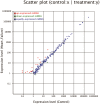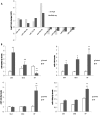Differential microRNA Expression and Regulation in the Rat Model of Post-Infarction Heart Failure
- PMID: 27504893
- PMCID: PMC4978447
- DOI: 10.1371/journal.pone.0160920
Differential microRNA Expression and Regulation in the Rat Model of Post-Infarction Heart Failure
Abstract
Background: Heart failure is a complex end stage of various cardiovascular diseases with a poor prognosis, and the mechanisms for development and progression of heart failure have always been a hot point. However, the molecular mechanisms underlying the post transcriptional regulation of heart failure have not been fully elucidated. Current data suggest that microRNAs (miRNAs) are involved in the pathogenesis of heart failure and could serve as a new biomarker, but the precise regulatory mechanisms are still unclear.
Methods: The differential miRNA profile in a rat model of post-infarction heart failure was determined using high throughout sequencing and analyzed through bioinformatics approaches. The results were validated using qRT-PCR for 8 selected miRNAs. Then the expression patterns of 4 miRNAs were analyzed in different periods after myocardial infarction. Finally, gain- and loss-of-function experiments of rno-miR-122-5p and rno-miR-184 were analyzed in H2O2 treated H9c2 cells.
Results: In the heart failure sample, 78 miRNAs were significantly upregulated and 28 were downregulated compared to the controls. GO and KEGG pathway analysis further indicated the likely roles of these miRNAs in heart failure. Time-course analysis revealed different expression patterns of 4 miRNAs: rno-miR-122-5p, rno-miR-199a-5p, rno-miR-184 and rno-miR-208a-3p. Additionally, rno-miR-122-5p and rno-miR-184 were proved to promote apoptosis in vitro.
Conclusions: Differential profile and expression patterns of miRNAs in the rats model of post-infarction heart failure were found, and the pro-apoptotic roles of rno-miR-122-5p and rno-miR-184 were revealed. These findings may provide a novel way that may assist in heart failure diagnosis and treatment.
Conflict of interest statement
Figures





Similar articles
-
Changes in Rat Brain MicroRNA Expression Profiles Following Sevoflurane and Propofol Anesthesia.Chin Med J (Engl). 2015 Jun 5;128(11):1510-5. doi: 10.4103/0366-6999.157676. Chin Med J (Engl). 2015. PMID: 26021509 Free PMC article.
-
Identification of cold-responsive miRNAs in rats by deep sequencing.J Therm Biol. 2017 May;66:114-124. doi: 10.1016/j.jtherbio.2017.03.005. Epub 2017 Mar 24. J Therm Biol. 2017. PMID: 28477904
-
[Screening type II alveolar epithelial cell apoptosis related microRNA].Zhonghua Wei Zhong Bing Ji Jiu Yi Xue. 2013 Sep;25(9):546-9. doi: 10.3760/cma.j.issn.2095-4352.2013.09.010. Zhonghua Wei Zhong Bing Ji Jiu Yi Xue. 2013. PMID: 24059422 Chinese.
-
MicroRNAs: new players in heart failure.Mol Biol Rep. 2013 Mar;40(3):2663-70. doi: 10.1007/s11033-012-2352-y. Epub 2012 Dec 15. Mol Biol Rep. 2013. PMID: 23242657 Review.
-
MicroRNAs: effective elements in ear-related diseases and hearing loss.Eur Arch Otorhinolaryngol. 2017 Jun;274(6):2373-2380. doi: 10.1007/s00405-017-4470-6. Epub 2017 Feb 21. Eur Arch Otorhinolaryngol. 2017. PMID: 28224282 Review.
Cited by
-
Roles of MicroRNA-122 in Cardiovascular Fibrosis and Related Diseases.Cardiovasc Toxicol. 2020 Oct;20(5):463-473. doi: 10.1007/s12012-020-09603-4. Epub 2020 Aug 27. Cardiovasc Toxicol. 2020. PMID: 32856216 Free PMC article. Review.
-
The Impact of microRNAs in Renin-Angiotensin-System-Induced Cardiac Remodelling.Int J Mol Sci. 2021 Apr 30;22(9):4762. doi: 10.3390/ijms22094762. Int J Mol Sci. 2021. PMID: 33946230 Free PMC article. Review.
-
MicroRNA 199a-5p induces apoptosis by targeting JunB.Sci Rep. 2018 Apr 27;8(1):6699. doi: 10.1038/s41598-018-24932-9. Sci Rep. 2018. PMID: 29703907 Free PMC article.
-
MicroRNA miR-301a is a novel cardiac regulator of Cofilin-2.PLoS One. 2017 Sep 8;12(9):e0183901. doi: 10.1371/journal.pone.0183901. eCollection 2017. PLoS One. 2017. PMID: 28886070 Free PMC article.
-
Ghrelin Alleviates Angiotensin II-Induced H9c2 Apoptosis: Impact of the miR-208 Family.Med Sci Monit. 2018 Sep 23;24:6707-6716. doi: 10.12659/MSM.908096. Med Sci Monit. 2018. PMID: 30244257 Free PMC article.
References
-
- Iemitsu M, Miyauchi T, Maeda S, Sakai S, Kobayashi T, Fujii N, et al. Physiological and pathological cardiac hypertrophy induce different molecular phenotypes in the rat. American journal of physiology Regulatory, integrative and comparative physiology. 2001;281(6):R2029–36. . - PubMed
MeSH terms
Substances
LinkOut - more resources
Full Text Sources
Other Literature Sources
Medical

